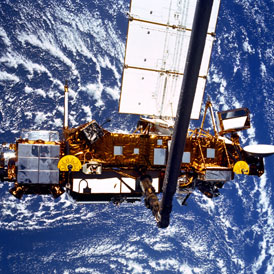Bus-sized satellite returns to earth
A defunct Nasa space satellite has re-entered the earth’s atmosphere, the US space agency has announced, although its precise re-entry time and location are not yet known.
The American space agency does not know when or where the 20-year-old upper atmosphere research satellite will fall, but it has said there is a one in 3,200 chance it will hit someone on earth.
The Nasa satellite, which is the size of a bus, is likely to crash to earth on Saturday, with the Pacific Ocean a likely destination. RAF Fylingdales, on the North York Moors, is using its radar to track its final orbit, helping to predict the path of its re-entry into the earth’s atmosphere.
An RAF spokeswoman said: “With the majority of the earth being covered by water, the chances of an impact on solid ground are slim to negligible. Whilst the object may survive the harsh conditions of its journey back to earth, it is important to remember that parts of the satellite, if not all of it, will burn up on re-entry.”
We’ve had only one person brushed on the shoulder. Dr William Ailor, Aerospace Corporation
Dr William Ailor, from the Aerospace Corporation, said that over the last 40 or 50 years, up to 100 objects a year had fallen to earth from space, but no-one had been hurt. “We’ve had only one person brushed on the shoulder by a very light piece of debris in all that time. And so, we all think that the probability of getting hit by something is very low.”

Burning up
It is the biggest Nasa spacecraft to fall uncontrolled from the sky in 32 years and is expected to break into more than 100 pieces as it enters the atmosphere, most of it burning up. Debris could be scattered over an area up to 300 miles long.
Dr Ailor said: “Basically what’s happening now is we’ve got a relatively large spacecraft that’s at the end of its life. It’s coming in to the atmosphere and it’s going to burn up and probably drop some debris some place on the planet.
“This is not an unusual event because we have about, let’s say, 20 to 40 of these things a year coming down. This one’s a little large, but we’ve had larger come down also. If you happen to be the lucky person that actually sees one of these things coming in, it’s quite a spectacular event.”
The satellite, which is 35ft long, was launched in 1991 by space shuttle Discovery to study the ozone layer and was decommissioned in 2005.